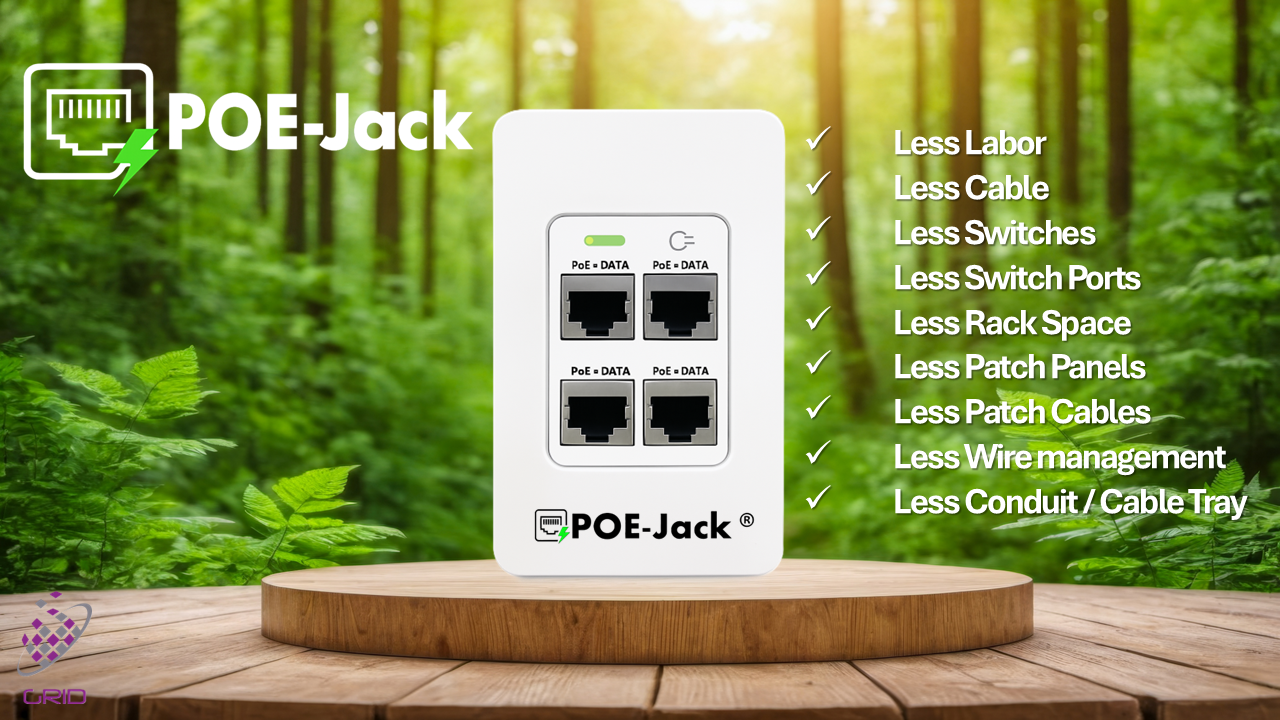
Contact Us
Reach out for connectivity and wire management solutions inquiries.
Location Details
Contact us for all your connectivity, transmission, and wire management solutions. We are here to assist you with your needs.
Warehouse locations
Dallas, TX USA
Surrey, BC Canada
Hours
9 AM - 4 PM Monday - Friday
Solutions
Innovative connectivity and wire management solutions provider.
Connect
Manage
info@poejack.com
702-505-7824
© 2025. All rights reserved.
Write your text here...
LEED and Network Cabling
LEED (Leadership in Energy and Environmental Design) is the world's most widely used green building rating system, providing a framework for healthy, efficient, and cost-saving sustainable buildings. Developed by the U.S. Green Building Council (USGBC).
In the evolving landscape of sustainable design, LEED certification has emerged as a benchmark for green building practices. The latest iteration, LEED v4, introduces a more rigorous approach to sustainability, emphasizing not only energy efficiency but also innovative materials and technologies. For electrical engineers involved in the design and implementation of network cabling in new buildings, understanding the components of LEED v4 and their implications is crucial.
LEED is a certification program established by the U.S. Green Building Council (USGBC) to encourage sustainable building practices. LEED v4, launched in 2013, is a comprehensive update that places greater emphasis on human health, resilience, and performance. It spans several categories: Location and Transportation, Sustainable Sites, Water Efficiency, Energy and Atmosphere, Materials and Resources, Indoor Environmental Quality, and Innovation. Each category comprises various credits that projects can earn to achieve different levels of certification—Certified, Silver, Gold, or Platinum.
For project credits for accreditation related to materials, LEED often specifies that the included products typically fall within CSI MasterFormat Divisions 3 through 10, 31, and 32. These divisions cover elements like concrete, masonry, metals, wood, finishes, and exterior/interior site work. Other divisions, like 22 (Mechanical), 23 (Plumbing) 26 (Electrical) 27 (Communications) and 28 (Electronic Safety and Security Systems) , are generally not included. Products considered "special equipment," such as elevators, escalators, process equipment, and fire suppression systems, are also typically excluded from credit calculations.
LEED V4 offers some changes, while Division 27 itself isn't a LEED credit, its products and systems can be used to contribute to Materials and Resources (MR) category credits, such as those requiring Environmental Product Declarations (EPDs) or contributing to the valuation of installed products. Specifically, passive components from Division 27, like conduits, can be included in cost-based credits or product-based credits, requiring their consistent reporting and consistent inclusion if a project chooses to include elements from this division.
In LEED V4 specifically, passive elements of Division 27, such as the cabling, conduit, and other non-powered physical components, can now be considered for credit. Here are some ways electrical engineers can contribute to LEED certification through thoughtful cabling specifications and installations:
1. Materials and Resources: Networking cables and other infrastructure components should adhere to sustainable sourcing and manufacturing practices. Engineers should look for cables that are made from recycled materials or those that have minimal environmental impact during production. Products with Environmental Product Declarations (EPDs) can contribute points toward LEED certification, as they provide transparent information about the environmental impacts of materials. Having solutions that use less packaging & less product required can be used for credits here.
2. Indoor Environmental Quality: The choices made in network cabling can significantly affect indoor air quality. Selecting products that are free from harmful chemicals, such as halogens or formaldehyde, is paramount. Engineers should prioritize low-emission cables and ensure proper installation to avoid issues that could compromise air quality. Certifications like UL Greenguard can also support compliance with LEED credits. LSZH (Low Smoke Zero Halogen) cables is not a National Electrical Code (NEC) or Canadian Electrical Code (CEC) rating or requirement but rather a descriptor of cable jacket composition and insulator chemical makeup. The "Zero Halogen" means it lacks halogens like chlorine or bromine, which release toxic, corrosive gases when burned. These LSZH cables are a type of insulated cable designed to release minimal smoke and no toxic halogen gases when exposed to fire, providing a safer alternative to traditional PVC-jacketed cables, especially in occupied or poorly ventilated areas like hospitals, schools, and public buildings. The cable's jacket is made from materials that undergo an endothermic (heat-absorbing) chemical reaction in a fire, releasing steam to cool the material and form a char layer, which limits flame spread and toxic gas emission. These LSZH cables are often not used due to high cost, but with cost savings of solutions like POE-Jack® it offers an opportunity to change this for LEED credits and better life safety while still providing cost savings.
3. Energy Efficiency: One of the most significant contributions network cabling can make towards LEED v4 is in designing energy-efficient systems. Utilizing Ethernet cabling that supports Power over Ethernet (PoE) can reduce the need for separate power outlets, thereby leading to lower energy consumption. Additionally, implementing advanced cabling management systems can improve HVAC efficiency, as optimal networking layouts may enhance airflow and thermal management.
4. Innovation: Network infrastructure is critical for smart building technologies. Electrical engineers can integrate Internet of Things (IoT) devices that monitor energy usage, indoor climates, and occupancy rates, contributing to building performance optimization. Innovations that enhance building efficiency can provide additional credits in the Innovation category of LEED v4.
5. Sustainable Practices: Employing sustainable installation practices, such as recycling old cabling or using environmentally friendly installation materials, not only contributes to the overall sustainability of the project but may also align with LEED prerequisites.
LEED v4 presents an opportunity for electrical engineers to play a pivotal role in sustainable building practices through thoughtful network cabling design and implementation. By focusing on material selection, energy efficiency, and innovative integration, engineers can aid in achieving LEED certification while fostering an environmentally responsible future. Understanding and applying these principles is not just beneficial for project success; it is essential in the pursuit of a greener, more sustainable built environment.
New solutions offered by GRID Networking and the POE-Jack® offers some great environmental benefits from saving up to 75% less cabling required, 75% less patch cables, 75% less patch panels, 75% less switch ports, less cable management, less racks, less conduit and less packaging for all the items.
POE-Jack® disrupts the structured cabling industry that has been long stagnant without innovation in the copper premise cabling industry. POE-Jack® requires 1 cable, 1 patch panel port and 1 POE switch port all while providing a 4 ports Ethernet Outlet plate. Compared to traditional jack / patch panel products that require a dedicated cable for each port, so 4 cables, 4 patch panel ports and 4 switch ports that is substantially more product required but also a much larger footprint in racks, cabinets and in telecommunication rooms/closets. The environmental benefit to the reduction of these items is tremendous, the amazing part of it is that it saves money too that can help offset those other LEED requirements that often raise the costs of a project.
POE-Jack® functions as a PoE-powered Gigabit switch integrated into the wall outlet plate, and yes a quarter off that bandwidth is way beyond the needs of 99.5% of the market needs in office environments. Compression / Codec of video streaming has kept bandwidth low, some examples being Netflix 4K Ultra HD is less than 25mbps, Zoom HD is 3.8 Mbps and Teams group video calls are under 10 Mbps. So Gigabit (1000mbps) divided by 4 outlets is more than plenty. The Structured cabling industry has been pushing bandwidth cables for future proofing that has not been required in premises due to technology. Cat6 became a standard in 2002, offering Gigabit to the desktop, many different types of construction and gauges of wire have been used for this. POE standards (802.3af/at/bt) have evolved, IEEE 802.3af (ratified in 2003), IEEE 802.3at (PoE+, ratified in 2009), and IEEE 802.3bt (PoE++, ratified in 2018) have given new purpose to cable in the market to power wireless access points, network cameras, digital signage and even monitors. POE-Jack® runs on less than 2.5w and can be used to extend network distances by cascading them for applications of adding network cameras or wireless access points in parkades, warehouses, airports, campuses, up risers of high rises and many more applications.
The gauge of the wire used in Cat6 becomes more important when using for higher wattage requirements. This is why GRID Networking / POE-Jack® standardized on 23awg Cat6e cable, it is a Cat6 cable by all definition but enhanced with 23awg wires allow for less voltage drop and optimal performance when IEEE 802.3bt POE++ 100w from POE Switch to 95w at POE Device.
For applications such as POS – Point of Sale terminals and Digital Signage again this reduces the cabling needed but adapters are also offered for non-POE systems to adapt them to POE-Jack®.
There is a 3600w 48 Port POE-Switch with hot swappable and dual redundant fans / power supplies to power POE-Jack®, Network Cameras, Access Points, POS and Digital Signage systems.
LEED is advancing to provide opportunity for solutions like POE-Jack® and we look forward to more expansion within the master format credits like this provides.
GRID Networking POE-Jack (POE Jack, POE-Jack® , POE-Jack™ ) truly is the most GREEN environmentally friendly network cabling solution.
GRID Networking POE-Jack (POE Jack, POE-Jack® , POE-Jack™ ) campus / enterprise level POEJK-S48-3600 POE switch is one of the most powerful POE switches in the market with a 3600 watt POE budget.
GRID Networking POE-Jack (POE Jack, POE-Jack® , POE-Jack™ ) POEJK6A-VI is one of the highest performance Cat6a Cat6e Cat6 RJ45 MPTL Crimp Ends, with their Staggered Sled insert for keeping conductors separated for lower crosstalk, it has 50 micron gold plated 4 prong contacts for the best performance.


